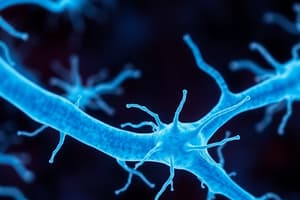Podcast
Questions and Answers
Which cranial nerve is responsible for transmitting visual information?
Which cranial nerve is responsible for transmitting visual information?
- Cranial Nerve II (correct)
- Cranial Nerve V
- Cranial Nerve X
- Cranial Nerve VIII
Which division of the nervous system is responsible for controlling involuntary bodily functions?
Which division of the nervous system is responsible for controlling involuntary bodily functions?
- Somatic nervous system
- Autonomic nervous system (correct)
- Central nervous system
- Peripheral nervous system
What type of neural cells provides support and nourishment to the central nervous system?
What type of neural cells provides support and nourishment to the central nervous system?
- Microglia
- Astrocytes (correct)
- Oligodendrocytes
- Schwann cells
Which type of neuron has an uninterrupted axon?
Which type of neuron has an uninterrupted axon?
What type of neural cell in the peripheral nervous system is responsible for the myelin sheaths?
What type of neural cell in the peripheral nervous system is responsible for the myelin sheaths?
Which organelle of the neuron is responsible for the production of neurotransmitters?
Which organelle of the neuron is responsible for the production of neurotransmitters?
A patient has experienced a stroke. Which part of the nervous system is most likely affected?
A patient has experienced a stroke. Which part of the nervous system is most likely affected?
What can the postsynaptic membrane be?
What can the postsynaptic membrane be?
What type of neuron will increase in number?
What type of neuron will increase in number?
What is the effect of acetylcholine in the synapse?
What is the effect of acetylcholine in the synapse?
Which of the following structures is present in a chemical synapse?
Which of the following structures is present in a chemical synapse?
Which ion is responsible for the depolarization of the presynaptic membrane?
Which ion is responsible for the depolarization of the presynaptic membrane?
What is the result of destruction of ependymal cells in the ventricles of the brain?
What is the result of destruction of ependymal cells in the ventricles of the brain?
What is the term for the network of nerves that integrates sensory and motor neurons?
What is the term for the network of nerves that integrates sensory and motor neurons?
Which spinal nerves contribute to the formation of the brachial plexus?
Which spinal nerves contribute to the formation of the brachial plexus?
What is the term for the proper end of the cone-shaped portion of the spinal cord?
What is the term for the proper end of the cone-shaped portion of the spinal cord?
Flashcards are hidden until you start studying
Study Notes
Cranial Nerves
- Cranial Nerve II is responsible for vision.
Nervous System Divisions
- The Autonomic nervous system is responsible for involuntary bodily functions, such as heart rate and digestion.
- The Somatic nervous system is responsible for voluntary control of skeletal muscles.
- The Peripheral nervous system is responsible for transmitting sensory and motor signals between the central nervous system and the rest of the body.
Physiological Responses
- The Autonomic nervous system is primarily responsible for physiological responses, such as increased heart rate, rapid breathing, and muscle tension, in response to a sudden threat.
Neural Cells
- Astrocytes are responsible for the support and nourishment of the central nervous system.
- Schwann cells are responsible for the myelin sheaths in the peripheral nervous system.
Neuron Organelles
- The Golgi Apparatus is responsible for the production of neurotransmitters in neurons.
Synapses
- The postsynaptic membrane can be a muscle, gland, or nerve.
- Acetylcholine is a neurotransmitter that causes muscle contraction at the synapse.
- The structures needed for a chemical synapse are neurotransmitter, synaptic cleft, pre- and post-synaptic membranes.
Ion Flow
- Calcium is responsible for the depolarization of the presynaptic membrane.
Ventricles of the Brain
- Destruction of the ependymal cells in the ventricles of the brain causes a loss of cerebrospinal fluid and may lead to hydrocephalus.
Nerve Networks
- A plexus is a network of nerves found primarily in the peripheral nervous system that integrates sensory and motor neurons to innervate specific regions of the body.
- The brachial plexus is formed by spinal nerves C5, C6, C7, C8, and T1.
- The sacral plexus is formed by spinal nerves L4, L5, S1, S2, S3, and S4.
Spinal Nerves
- There are 31 spinal nerves in total.
- The Conus Medullaris is the proper end of the cone-shaped portion of the spinal cord.
- The Cauda Equina is a structure located distally to the conus medullaris.
Studying That Suits You
Use AI to generate personalized quizzes and flashcards to suit your learning preferences.




